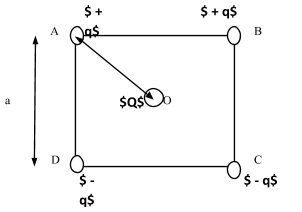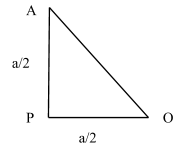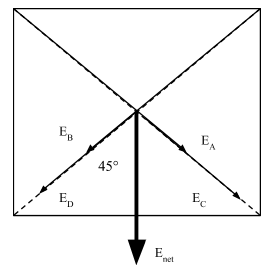
Four charges $ + q $ , $ + q $ , $ - q $ and $ - q $ are replaced at corners A,B,C, and D of a square of side ‘a’, arranged in the given order. Calculate the intensity of the Electric Field at the center of the square where $ Q $ is placed.
(A) $ zero $
(B) $ \dfrac{{K4\sqrt 2 qQ}}{{{a^2}}} $
(C) $ \dfrac{{K4qQ}}{{{a^2}}} $
(D) $ \dfrac{{K2\sqrt 2 qQ}}{{{a^2}}} $
Answer
556.8k+ views
Hint To solve this question, we have to calculate the electric field due to each charge placed at the corner. Then we need to perform the vector summation of these fields to get the net electric field at the center.
Formula Used: The formula used in this solution is given as,
$ \Rightarrow E = \dfrac{{Kq}}{{{r^2}}} $
Here, $ E $ is the electric field, $ q $ is the charge, $ r $ is the distance between the charge $ q $ and the test charge $ Q $ , and $ K = \dfrac{1}{{4\pi {\varepsilon _\circ }}} $ where, $ {\varepsilon _\circ } $ is the permittivity in free space,
$ \Rightarrow F = QE $
Here, $ F $ is the electric force due to an electric field $ E $ on a test charge $ Q $ .
Complete step by step answer
Let us first try to represent the data given in the question diagrammatically.

Now, if we let a point P at the midpoint of AD, then, using Pythagoras theorem we can write,
$\Rightarrow A{O^2} = A{P^2} + P{O^2} $

This gives us,
$ \Rightarrow AO = \sqrt {{{\left( {\dfrac{a}{2}} \right)}^2} + {{\left( {\dfrac{a}{2}} \right)}^2}} $
$ \Rightarrow AO = \dfrac{a}{{\sqrt 2 }} $
Now using the fact that opposite charges attract each other and the same charges repel each other, Let us show diagrammatically, how the following Electric Fields from the 4 charges will act at the center O.

In the figure we get the angle to be 45°, because we know that each side makes an angle of 90° with the other side and the diagonal bisects the angle into two equal parts. Hence, by the property of alternate angles, we get,
$ \Rightarrow \angle ACO = \angle CO{E_{net}} = 45^\circ $
We already know that since Electric Fields follow the principle of superposition, we can write,
$ \Rightarrow \overrightarrow {{E_{net}}} = \overrightarrow {{E_A}} + \overrightarrow {{E_B}} + \overrightarrow {{E_C}} + \overrightarrow {{E_D}} $
Now, using the diagram drawn above, we get, $ {E_{net}} $ as,
$\Rightarrow \overrightarrow {{E_{net}}} = \left| {\overrightarrow {{E_A}} } \right|\cos 45 + \left| {\overrightarrow {{E_B}} } \right|\cos 45 + \left| {\overrightarrow {{E_C}} } \right|\cos 45 + \left| {\overrightarrow {{E_D}} } \right|\cos 45 $
Now, if we let $ E $ to be the magnitude of Electric field due to a single charge, i.e.
$\Rightarrow E = \left| {\overrightarrow {{E_A}} } \right| $
$\Rightarrow E = \dfrac{{Kq}}{{{{\left( {\dfrac{a}{{\sqrt 2 }}} \right)}^2}}} $
We can easily infer that,
$\Rightarrow E = \left| {\overrightarrow {{E_A}} } \right| = \left| {\overrightarrow {{E_B}} } \right| = \left| {\overrightarrow {{E_C}} } \right| = \left| {\overrightarrow {{E_D}} } \right| $
So, we can write the net Electric Field as,
$\Rightarrow \overrightarrow {{E_{net}}} = E\cos 45 + E\cos 45 + E\cos 45 + E\cos 45 $
$ \Rightarrow \overrightarrow {{E_{net}}} = 4E\cos 45 $
Now since we know the value of E and $ \cos 45 = \dfrac{1}{{\sqrt 2 }} $
Thus, we get the net Electric field as,
$ \overrightarrow {{E_{net}}} = 4\left( {\dfrac{{Kq}}{{\dfrac{{{a^2}}}{2}}}} \right)\left( {\dfrac{1}{{\sqrt 2 }}} \right) $
$ \Rightarrow \overrightarrow {{E_{net}}} = 4\left( {\dfrac{{2Kq}}{{{a^2}}}} \right)\left( {\dfrac{1}{{\sqrt 2 }}} \right) $
This gives us,
$ \Rightarrow \overrightarrow {{E_{net}}} = \dfrac{{4\sqrt 2 Kq}}{{{a^2}}} $
So, we get the intensity of the electric field as,
$ \Rightarrow F = QE $
$ \Rightarrow F = \dfrac{{4\sqrt 2 KqQ}}{{{a^2}}} $
$ \therefore $ Option (B) is the correct option.
Note
We should not forget that the electric field is a vector quantity, not a scalar quantity. So, the net electric field at the centre of the square cannot be obtained by the direct summation. The electric field vectors first need to be resolved into perpendicular components, and then the algebraic addition must be performed.
Formula Used: The formula used in this solution is given as,
$ \Rightarrow E = \dfrac{{Kq}}{{{r^2}}} $
Here, $ E $ is the electric field, $ q $ is the charge, $ r $ is the distance between the charge $ q $ and the test charge $ Q $ , and $ K = \dfrac{1}{{4\pi {\varepsilon _\circ }}} $ where, $ {\varepsilon _\circ } $ is the permittivity in free space,
$ \Rightarrow F = QE $
Here, $ F $ is the electric force due to an electric field $ E $ on a test charge $ Q $ .
Complete step by step answer
Let us first try to represent the data given in the question diagrammatically.

Now, if we let a point P at the midpoint of AD, then, using Pythagoras theorem we can write,
$\Rightarrow A{O^2} = A{P^2} + P{O^2} $

This gives us,
$ \Rightarrow AO = \sqrt {{{\left( {\dfrac{a}{2}} \right)}^2} + {{\left( {\dfrac{a}{2}} \right)}^2}} $
$ \Rightarrow AO = \dfrac{a}{{\sqrt 2 }} $
Now using the fact that opposite charges attract each other and the same charges repel each other, Let us show diagrammatically, how the following Electric Fields from the 4 charges will act at the center O.

In the figure we get the angle to be 45°, because we know that each side makes an angle of 90° with the other side and the diagonal bisects the angle into two equal parts. Hence, by the property of alternate angles, we get,
$ \Rightarrow \angle ACO = \angle CO{E_{net}} = 45^\circ $
We already know that since Electric Fields follow the principle of superposition, we can write,
$ \Rightarrow \overrightarrow {{E_{net}}} = \overrightarrow {{E_A}} + \overrightarrow {{E_B}} + \overrightarrow {{E_C}} + \overrightarrow {{E_D}} $
Now, using the diagram drawn above, we get, $ {E_{net}} $ as,
$\Rightarrow \overrightarrow {{E_{net}}} = \left| {\overrightarrow {{E_A}} } \right|\cos 45 + \left| {\overrightarrow {{E_B}} } \right|\cos 45 + \left| {\overrightarrow {{E_C}} } \right|\cos 45 + \left| {\overrightarrow {{E_D}} } \right|\cos 45 $
Now, if we let $ E $ to be the magnitude of Electric field due to a single charge, i.e.
$\Rightarrow E = \left| {\overrightarrow {{E_A}} } \right| $
$\Rightarrow E = \dfrac{{Kq}}{{{{\left( {\dfrac{a}{{\sqrt 2 }}} \right)}^2}}} $
We can easily infer that,
$\Rightarrow E = \left| {\overrightarrow {{E_A}} } \right| = \left| {\overrightarrow {{E_B}} } \right| = \left| {\overrightarrow {{E_C}} } \right| = \left| {\overrightarrow {{E_D}} } \right| $
So, we can write the net Electric Field as,
$\Rightarrow \overrightarrow {{E_{net}}} = E\cos 45 + E\cos 45 + E\cos 45 + E\cos 45 $
$ \Rightarrow \overrightarrow {{E_{net}}} = 4E\cos 45 $
Now since we know the value of E and $ \cos 45 = \dfrac{1}{{\sqrt 2 }} $
Thus, we get the net Electric field as,
$ \overrightarrow {{E_{net}}} = 4\left( {\dfrac{{Kq}}{{\dfrac{{{a^2}}}{2}}}} \right)\left( {\dfrac{1}{{\sqrt 2 }}} \right) $
$ \Rightarrow \overrightarrow {{E_{net}}} = 4\left( {\dfrac{{2Kq}}{{{a^2}}}} \right)\left( {\dfrac{1}{{\sqrt 2 }}} \right) $
This gives us,
$ \Rightarrow \overrightarrow {{E_{net}}} = \dfrac{{4\sqrt 2 Kq}}{{{a^2}}} $
So, we get the intensity of the electric field as,
$ \Rightarrow F = QE $
$ \Rightarrow F = \dfrac{{4\sqrt 2 KqQ}}{{{a^2}}} $
$ \therefore $ Option (B) is the correct option.
Note
We should not forget that the electric field is a vector quantity, not a scalar quantity. So, the net electric field at the centre of the square cannot be obtained by the direct summation. The electric field vectors first need to be resolved into perpendicular components, and then the algebraic addition must be performed.
Recently Updated Pages
A man running at a speed 5 ms is viewed in the side class 12 physics CBSE

The number of solutions in x in 02pi for which sqrt class 12 maths CBSE

State and explain Hardy Weinbergs Principle class 12 biology CBSE

Write any two methods of preparation of phenol Give class 12 chemistry CBSE

Which of the following statements is wrong a Amnion class 12 biology CBSE

Differentiate between action potential and resting class 12 biology CBSE

Trending doubts
What are the major means of transport Explain each class 12 social science CBSE

Which are the Top 10 Largest Countries of the World?

Draw a labelled sketch of the human eye class 12 physics CBSE

Explain sex determination in humans with line diag class 12 biology CBSE

Explain sex determination in humans with the help of class 12 biology CBSE

Differentiate between homogeneous and heterogeneous class 12 chemistry CBSE




